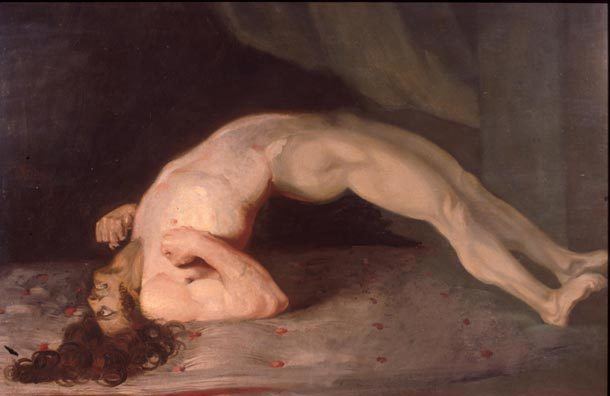ICD-9-CM 781.0 MedlinePlus 003195 | DiseasesDB 31293 | |
 | ||
Opisthotonus or opisthotonos, from Greek roots, ὄπισθεν, opisthen meaning "behind" and τόνος tonos meaning "tension", is a state of severe hyperextension and spasticity in which an individual's head, neck and spinal column enter into a complete "bridging" or "arching" position. This abnormal posturing is an extrapyramidal effect and is caused by spasm of the axial muscles along the spinal column.
Causes
It is seen in some cases of severe cerebral palsy and traumatic brain injury or as a result of the severe muscular spasms associated with tetanus. It can be a feature of severe acute hydrocephalus.
Opisthotonus can be produced experimentally in animals by transection of the midbrain (between the superior colliculus and the inferior colliculus), which results in severing all the corticoreticular fibers. Hyperextension occurs due to facilitation of the anterior reticulospinal tract caused by the inactivation of inhibitory corticoreticular fibers, which normally act upon the pons reticular formation. It has been shown to occur naturally only in birds and placental mammals.
Opisthotonus is more pronounced in infants. Opisthotonus in the neonate may be a symptom of meningitis, tetanus, severe kernicterus, or the rare Maple syrup urine disease. This marked extensor tone can cause infants to "rear backwards" and stiffen out as the mother or nurse attempts to hold or feed them. Opisthotonus can be induced by any attempt at movement such as smiling, feeding, vocalization, or by seizure activity. A similar tonic posturing may be seen in Sandifer syndrome. Individuals with opisthotonus are quite challenging to position, especially in wheelchairs and car seats.
Opisthotonus can sometimes be seen in lithium intoxication. It is a rare extrapyramidal side effect of phenothiazines, haloperidol, and metoclopramide.
Opisthotonus with the presence of the risus sardonicus is also a symptom of strychnine poisoning.
Opisthotonus is also described as a potential CNS symptom of heat stroke along with bizarre behavior, hallucinations, decerebrate rigidity, oculogyric crisis and cerebellar dysfunction.
Opisthotonus is seen with drowning victims – called the "Opisthotonic Death Pose". This pose is also common in complete dinosaur skeletal fossils and it has been suggested that this is due to the animal drowning or being immersed in water soon after death.
